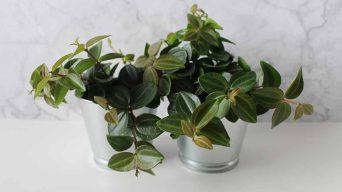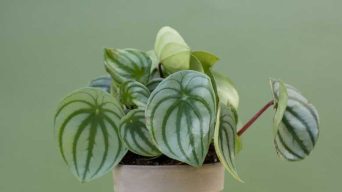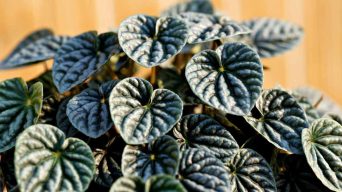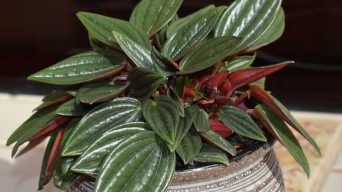Key Takeaways
- Peperomia leaves turning black can be caused by overwatering, poor drainage, low humidity levels, fungal or bacterial infections, overfertilization, and incorrect temperature and light conditions.
- To prevent black leaves on your Peperomia plant, adjust the watering frequency and quantity, repot in well-draining soil, increase humidity levels with a humidifier, or mist the plant regularly. Use fungicides or bactericides to treat any infections identified.
- Proper hygiene is also crucial; keep the plants and their containers clean and debris-free. Prune affected areas as necessary to prevent further spreading of disease.
- Prevention is vital; avoid overfertilizing and exposing your Peperomia plant to too much direct sunlight. Help ensure its optimal growth by providing a good-quality potting mix and appropriate drainage materials such as perlite or sand for good airflow that prevents soil compaction leading to root rot.
Peperomia plants, known for their attractive foliage and easy-to-grow nature, are popular among plant enthusiasts.
However, black leaves on your beloved radiator plant can be alarming and disheartening.
Identifying the cause of these discolored leaves is crucial to nursing your indoor garden back to health.
In this blog post, we’ll explore the factors that may result in Peperomia leaves turning black – from overwatering and poor drainage to infections or environmental stressors – and provide expert solutions for each issue.
What Causes Peperomia Leaves To Turn Black
If you notice black leaves on your Peperomia plant, it may be due to overwatering, poor drainage, low humidity, fungal or bacterial infections, overfertilization, or incorrect temperature and light conditions.
Overwatering
Overwatering is the most common cause of black leaves in Peperomia plants, leading to root rot and other fungal infections.
When Peperomias receive too much water, their roots can become damaged due to a lack of oxygen, which causes them to start rotting.
To avoid overwatering your Peperomia plant, wait until the top inch or so of the potting mix is dry before watering it again.
Since these tropical plants are drought-tolerant by nature, they prefer periods of dryness between waterings.
Additionally, consider using a moisture meter or simply inserting your finger into the soil to gauge its moisture level accurately.
Remember that environmental factors such as temperature and humidity affect how often you water your Peperomia houseplant.
During warmer months or in low-humidity conditions, you may find yourself watering more frequently than during cooler months when less evaporation occurs.
Poor Drainage
Poor drainage is a prevalent issue that can cause Peperomia leaves to turn black as the roots suffocate in waterlogged soil.
When the roots cannot take in oxygen and nutrients properly due to excess moisture, this can lead to leaf discoloration and, eventually, complete deterioration into a blackened state.
To avoid the pitfalls of poor drainage with your radiator plant, use a well-draining potting mix of ingredients like peat moss or cactus soil.
You can incorporate perlite or pumice into your potting mixture to increase its porosity and enhance overall drainage capabilities.
Additionally, selecting pots with sufficient holes at the bottom will aid in preventing standing water within thick stem cuttings’ base environment.
Low Humidity
Low humidity is a common issue that can cause Peperomia leaves to turn black.
Tropical plants thrive in environments with higher moisture levels; however, indoor settings such as air-conditioned rooms or heated homes during winter often have significantly lower humidity levels.
To combat low humidity and help your Peperomia regain its vibrant green foliage, you can try various methods, like using a humidifier or regularly misting the plant with water.
Another effective solution is placing a tray filled with pebbles and water beneath the pot—this creates a microclimate of increased humidity around the plant without overwatering it directly.
Fungal Or Bacterial Infection
Fungal or bacterial infections are common culprits when Peperomia leaves turn black.
For instance, the fungal infection Phyllosticta sojicola can cause circular dry spots with yellow margins on the leaves, during a bacterial infection such as Rhizoctonia sp. may lead to mushy, dark-brown to black leaf spots.
If you suspect your Peperomia is experiencing a fungal or bacterial infection, it’s crucial to address it immediately.
One effective way is to treat the affected plant with appropriate fungicides or bactericides available at most garden centers.
Preventing these infections requires maintaining proper hygiene by keeping your plants and their containers clean and free from debris.
Overfertilization
Overfertilization can cause Peperomia leaves to turn black.
While fertilizer is important for the growth and development of plants, too much of it can harm them.
When you give your Peperomia plant excess nutrients, it experiences a buildup of salts that can accumulate in the soil over time.
To prevent overfertilizing your Peperomia, follow instructions on fertilizers carefully or only fertilize once every few months during the growing season.
Consider using a balanced liquid fertilizer with an equal ratio of nitrogen, phosphate, and potassium (NPK).
It is also essential to use high-quality soil with appropriate drainage materials, such as perlite or sand, mixed into the potting mix for good aeration and to prevent soil compaction that may lead to root rot.
Temperature
Maintaining the ideal temperature is crucial for keeping your Peperomia plant healthy.
The optimal temperature range for this plant species is between 55°F (12°C) and 80°F (26°C).
If temperatures fall below or exceed this range, it can lead to yellowing leaves and the ultimate death of your Peperomia plant.
On the other hand, exposing your plants to extreme heat through radiators or direct sunlight may cause scorching on their leaves, resulting in black spots.
Similarly, placing them near windows that receive direct sunlight can also be detrimental as they are not tolerant of high light intensity.
Incorrect Light
Peperomia plants need the right amount of light to thrive; incorrect lighting can cause their leaves to turn black.
Peperomias may develop scorched leaves that eventually turn black and die when exposed to direct sunlight for too long.
To prevent this issue, place your Peperomia in a location that receives bright indirect sunlight for most of the day.
Avoid placing them in areas with direct sunlight or near heat sources such as radiators or vents.
If you notice your Peperomia’s leaves turning black due to lighting problems, adjust its position accordingly and prune any damaged foliage away.
How To Remedy Black Peperomia Leaves
If you notice black leaves on your Peperomia plant, there are several ways to fix it.
Adjusting how often and how much you water it, repotting it using well-draining soil, increasing humidity levels, using fungicides or bactericides, trimming off affected leaves and stems, and addressing environmental issues.
These solutions can effectively remedy the problem.
Adjusting Watering Frequency And Quantity
Proper watering is crucial to keeping your Peperomia healthy.
Here are some tips to help you adjust the watering frequency and quantity:
- Check the soil moisture: Before watering, stick your finger into the soil up to the second knuckle. If the soil feels dry, it’s time to water.
- Water less frequently: Overwatering is a common cause of black leaves on Peperomia plants. Reduce the watering frequency and quantity if you notice signs of overwatering.
- Use room temperature water: Using tap water at room temperature is best for Peperomia plants. Avoid using cold or hot water as it can shock the roots.
- Keep water from sitting in the tray: Water that sits in the drainage tray beneath your plant can lead to root rot and other issues. Empty any excess water in the tray after watering.
- Increase humidity levels: Increasing humidity around your plant can help reduce its need for frequent watering. Consider placing a humidifier nearby or grouping plants for increased humidity levels.
Repotting In Well-draining Soil
If you want to prevent your Peperomia plant’s leaves from turning black, one of the crucial steps is repotting it in well-draining soil.
Here are some things to keep in mind:
- Choose a pot with drainage holes at the bottom.
- Use a good-quality potting mix that includes perlite or sand for improved drainage.
- Avoid using regular soil or heavy potting mixes that retain too much moisture.
- Gently remove the plant from its old pot and loosen any compacted roots before placing it in the new one.
- Add fresh soil around the roots, ensuring not to bury the stem too deep.
- Water lightly and let drain thoroughly before placing it back in its usual spot.
Increasing Humidity Levels
One of the common causes of blackening Peperomia leaves is low humidity levels in the environment.
Therefore, increasing humidity levels can help remedy this problem.
Here are some ways to increase humidity levels for your Peperomia plant:
- Misting: Using a spray bottle filled with water, spritz the leaves of your Peperomia plant regularly to provide it with additional moisture.
- Grouping plants: Grouping your plants close together can create a microclimate that increases their humidity levels.
- Humidifiers: Investing in a humidifier can increase humidity levels around your Peperomia plant.
- Pebble trays: Place a layer of pebbles or stones at the bottom of a tray and fill it with water up to half level. Then place your plant on top of the pebbles – not directly in the water – so that as the water evaporates, it will increase the humidity around your plant.
- Bathroom or kitchen placement: Your bathroom or kitchen is often more humid than other parts of your home due to daily activities such as showering or cooking, making it an ideal location for your plant.
Remember that each method works differently for different environments and plants, so if necessary, find what works best for yours through trial and error.
Treating With Fungicides Or Bactericides
When dealing with black Peperomia leaves caused by fungal or bacterial infections, a few treatments can help remedy the issue.
Here are some options:
- Use a fungicide: Applying a fungicide to the soil and foliage can help eliminate any fungal spores causing issues. Follow the product instructions carefully for application and dosage.
- Apply a bactericide: If a bacterial infection is identified, applying a suitable bactericide can help destroy the harmful bacteria. Again, follow instructions carefully for application and dosage.
- Mix neem oil solution: Neem oil has antifungal and antibacterial properties that can combat infections. Mix 1 teaspoon of neem oil with 1 quart of water in a spray bottle, shake well, and mist the plant’s leaves once a week.
- Quarantine infected plants: If Peperomia plants nearby haven’t been affected, it’s best to quarantine the affected plant away from healthy ones until it recovers.
- Prune affected areas: Remove severely damaged leaves and stems with sterile pruning shears to prevent the further spreading of the disease.
Remember to properly diagnose the issue before administering any treatment and read instructions carefully when using chemicals.
Pruning Affected Leaves And Stems
If your Peperomia leaves have turned black, it might be necessary to prune affected parts of the plant to prevent further damage.
Here are some steps to follow when pruning Peperomia plants:
- Take a pair of clean and sharp scissors or pruning shears.
- Inspect the affected leaves and stems carefully and identify those turning black.
- Cut the affected parts off at the base or where they meet healthy tissue.
- Sterilize your tools before making any cuts to avoid spreading diseases.
- Dispose of the pruned parts properly, away from other plants.
Pruning can help promote new growth and encourage better-growing conditions by removing diseased or damaged tissues that could harbor pathogens.
Addressing Environmental Factors
Addressing environmental factors that can affect the plant’s health is essential to prevent Peperomia leaves from turning black.
Here are some tips for keeping your Peperomia thriving:
- Provide Bright Indirect Light: Most Peperomia varieties thrive in bright but indirect sunlight. Ensure they receive at least 6 hours of light daily, but be careful not to expose them to direct sun rays, which can cause the leaves to burn.
- Maintain Optimal Temperature: Peperomias prefer warm temperatures between 65°F and 75°F during the day and slightly cooler temperatures at night. Avoid exposing them to cold drafts or excessively high temperatures.
- Increase Humidity Levels: Peperomias originate from tropical regions with high humidity levels, so they prefer moist environments. To increase humidity levels around your Peperomia plants, mist them regularly or place a humidifier nearby.
- Use High-Quality Soil: A well-draining potting mix that allows excess water to drain quickly prevents root rot and black spots on leaves.
- Avoid Overfertilization: Overfertilization can lead to excessive salt buildup in the soil, which can damage roots and cause Peperomia leaves to turn black. Follow recommended fertilization guidelines for your specific variety of Peperomia.
Prevention Tips For Black Peperomia Leaves
Taking good care of the plant is essential to keep your Peperomia leaves from turning black.
Make sure to give it the right amount of water and sunlight, use good soil and drainage materials, and watch for any signs of stress or illness.
Don’t overfertilize, and keep the plant away from direct sunlight.
Following these steps can help your Peperomia thrive and stay healthy.
Providing Proper Care Based On The Plant’s Needs
Your Peperomia plant will thrive when you provide it with proper care.
Here are some tips to help you care for your Peperomia plant:
- Water your Peperomia plant only when the soil is dry to the touch. Overwatering can lead to root rot and black leaves, while underwatering can cause the leaves to curl or fade.
- Provide your plant with bright indirect light. Avoid placing your Peperomia in direct sunlight as it may scorch the foliage.
- Fertilize your plant sparingly during the growing season using a balanced or specifically formulated houseplant fertilizer.
- Keep humidity levels high by misting your plant regularly or placing a water tray nearby.
- Repot your Peperomia into fresh soil every one to two years, ensuring that the new pot has adequate drainage holes and the soil is well-draining.
Regularly Inspecting The Plant For Signs Of Stress Or Illness
Regularly inspecting your Peperomia plant is essential to keeping it healthy and happy.
Here are some signs of stress or illness to look out for:
- Yellowing leaves: This can be a sign of overwatering, underwatering, nutrient deficiencies, or pests.
- Drooping leaves: Peperomia plants prefer well-draining soil, so if the soil is too damp or doesn’t have enough drainage, the leaves may start to droop.
- Slow or no growth: If your Peperomia plant isn’t growing as much as it used to, this could be a sign that it needs more light, nutrients, or water.
- Crispy leaves: If the edges of your Peperomia leaves curl up and turn brown, this could indicate low humidity levels.
- Black spots on leaves: This is often a sign of fungal or bacterial infection, which can be caused by overwatering or poor air circulation.
Regularly monitoring your Peperomia plant for these signs of stress or illness can catch problems early and take action before they become more severe.
Using High-quality Soil And Appropriate Drainage Materials
Peperomia plants require good drainage to prevent the blackening of leaves.
Using high-quality soil and appropriate drainage materials is important to maintain the health of your peperomia plant.
Here are some tips:
- Use a well-draining potting mix that contains perlite, sand, or pebbles.
- Avoid using heavy, clay soils that retain moisture for too long.
- Ensure enough drainage holes at the bottom of the pot to allow excess water to escape.
- Place a layer of stones or gravel at the bottom of the pot to improve drainage.
- Water your peperomia deeply but less frequently, allowing the soil to dry out slightly between watering sessions.
Following these guidelines, you can provide your peperomia plant with an optimal growing environment and reduce the risk of black leaves caused by poor drainage and soggy soil.
Avoiding Overfertilization
Overfertilizing your Peperomia plant can lead to a fungal infection, which can cause black leaves.
Here are some tips to avoid overfertilization and keep your plant healthy:
- Use a high-quality fertilizer explicitly designed for Peperomia plants.
- Follow the instructions on the label carefully, and do not exceed the recommended amount of fertilizer.
- Fertilize your Peperomia only during the growing season when it needs extra nutrients.
- Monitor your plant closely for signs of stress or nutrient deficiency, and adjust fertilization accordingly.
- Avoid tap water containing high levels of minerals, which can also contribute to overfertilization.
Keeping The Plant Away From Direct Sunlight
Exposure to too much light can cause Peperomia leaves to burn and turn black.
To prevent this, keep your plant away from direct sunlight and place it in an area that receives bright, indirect light.
Here are some tips:
- Position the plant near a north or east-facing window where it receives filtered light.
- If you need to place the plant near a south or west-facing window, filter the light with sheer curtains or blinds.
- Avoid placing the plant in direct sunlight, as it can scorch the leaves.
- Regularly monitor the amount of light your Peperomia is receiving and adjust accordingly.
By following these simple steps, you will ensure that your Peperomia gets enough light without causing any damage to its foliage.
Final Thoughts
Black leaves on your Peperomia can be a sign of various issues.
Overwatering, poor drainage, low humidity, and pests can all cause the leaves to turn black.
Fortunately, there are several remedies you can try to nurse your plant back to good health.
By adjusting watering frequency, improving soil drainage, and providing appropriate light and humidity levels, you can help prevent future black leaves on your Peperomia.
Remember that prevention is vital – don’t overfertilize or expose your plant to too much direct sunlight.







